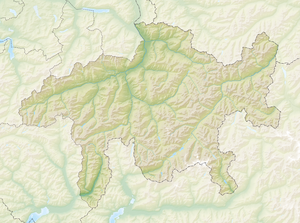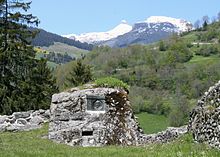Jörgenberg Castle (Waltensburg)
| Jörgenberg Castle | ||
|---|---|---|
|
Jörgenberg ruins |
||
| Alternative name (s): | Munt is called Gieri | |
| Creation time : | 765 | |
| Castle type : | Höhenburg, spur location | |
| Conservation status: | ruin | |
| Place: | Waltensburg | |
| Geographical location | 46 ° 46 '49 " N , 9 ° 8' 17" E | |
| Height: | 939 m above sea level M. | |
|
|
||
The ruin Jörgenberg ( Romansh Munt sogn Gieri ) is in Waltensburg in the Swiss canton of Graubünden . It is the largest castle complex in the Surselva .
location
The ruin of the Spornburg lies on the outermost rock spur of a long ridge east of Waltensburg (municipality of Breil / Brigels ). Along with Kropfenstein , Burg Grünenfels and Burg Vogelberg, Jörgenberg was one of the original four castles in Waltensburg and was already settled in the Middle Bronze Age.
history
Jörgenberg is first mentioned in 765 in Bishop Tello's testament as castellum . Another early mention can be found in the Rhaetian Imperial Surbar from the middle of the 9th century: There is already talk of the ecclesia sancti Georgii in Castello , the St. George's Church in the castle. This makes the Jörgenburg one of the earliest castles in Graubünden that has been documented in writing. The mentions confirm that the later castle complex emerged from an early medieval church building. After the 9th century, the Jörgenberg were missing documents for a long time.
Written sources are only available again at the beginning of the 14th century, when it appears as the property of the Lords of Friberg . These were of the noble class and had their seat above the village of Siat not far from Waltensburg. Few ruins have been preserved from their ancestral castle. Before they died out, the Friberger had transferred both castles to Austria in 1330 and received them back as fiefs .
After the death of the last Friberger around 1330, the powerful barons of Vaz claimed the fiefdom and occupied Jörgenberg in order to forestall an Austrian occupation. These resisted and allied themselves with the barons of Rhäzüns . However, Austria recognized the claims of the House of Vaz in 1341/1342. The Jörgenberg was given, together with the seat of the Friberger in Siat, as a fief of Ursula von Vaz, who was married to Rudolf von Werdenberg-Sargans , (* 1310).
In 1343 the Counts of Werdenberg, as heirs of the House of Vaz, renounced all rights to the two castles and in the same year left them to the Barons of Rhäzuns for compensation of 1,000 marks . In 1378 they bought the neighboring rule of the Lords of Grünenfels and united the two areas to form the new rule Jörgenberg. In 1430 the Rhäzünser received confirmation of the ban on Sankt Jörgenberg from King Sigismund . The castle subsequently became the center of an important dominion center with the seat of a castellan with far-reaching powers.
After the Rhäzünser died out around 1450, Jörgenberg came into the possession of Jos Niclaus von Zollern in 1458, after a long inheritance dispute, whose mother Ursula was a member of the "Lords of Rhäzüns". Count Jörg von Werdenberg was compensated with 3,000 Reich gulden and waived any further claims.
In 1462 von Zollern sold the Jörgenberg estate to the Disentis monastery, with the reservation of certain areas and regional mining rights . However, the castle continued to be a center for the entire rule and remained the seat of the castellan, who still collected the taxes. Prisoners were imprisoned there and, if convicted, executed on the nearby Gallows Hill.
In 1539 the Abbot of Disentis sold Jörgenberg to Mathias von Rungs (Surselvian gender name for Derungs ), who had to undertake to take care of the maintenance of the church. From 1580 the Gandreya family (Romanesque Candreja) owned the castle, which is said to have still been inhabited. His descendants sold the castle to the community in 1734, who still own it today. However, since the question of ownership was apparently still unclear, the community, which had meanwhile converted to the Reformed faith, bought itself free from the Disentis Monastery with the high amount of 4,500 guilders and thus came into legal possession of the castle. In the contract, which is in the community archive of Waltensburg, the abbot of Disentis had stipulated the title "Herr von Jörgenberg".
In the 17th century at the latest, the facility began to fall apart. In 1930, the Swiss Castle Association, under the direction of the architect Eugen Probst, carried out extensive uncovering and securing work. It was financed with funds from the estate of Anton Cadonau; a bronze plaque in the inner courtyard reminds of him. Unfortunately, the archaeological investigations were not carried out properly. From 1997 to 2001 the facility was completely preserved with contributions from the federal government, canton and municipality and numerous private donations.
investment
On the north and east sides, the facility was protected from any approach by a steep rock fall. On the steep but not impassable south side there are remains of external fortifications. In the west, the castle was separated from the ridge by a deep and wide moat .
The castle area has the shape of a triangle, the base of which is formed by the moat in the west. Here stood a mighty shield wall , the ruins of which are piling up here today. In front of this are the remains of older enclosing walls . In the south-west corner is the well-preserved, almost square, mighty keep ( residential tower ) with walls around two meters thick. The high entrance was on the east side and is designed as a round arched door, as is the exit to an arbor in the south wall. The five-storey building with Romanesque double arched windows on the top two floors was probably built shortly after 1265. A toilet bay was attached to the north wall . The building probably had a tent roof .
In the north-west corner of the complex there was a wing with several residential and farm buildings that had apparently been built in different construction phases: The Palas shortly after 1351, on the occasion of the rebuilding of the castle after a fire; the ancillary buildings and the northern enclosure wall along the northern edge of the plateau later.
These buildings may not have been inhabited until the end of the Middle Ages , but they were used as barns or storage rooms. Other buildings with an unknown purpose were located at the foot of the keep and in the eastern part of the area. The other outer bailey area was not built over, but only surrounded by a circular wall. From the outer gate in the south-west corner of the complex, a kennel led to the inner gate with a ditch in front. Most of the spacious inner courtyard was not built over. In the middle part is the cistern hewn out of the rock .
gallows
To the southwest of the castle complex are the two stone round pillars of the former gallows of Jörgenberg and Waltensburg at a distance of about 600 meters . They were restored in 1998.
St. George Church
Next to the gate, within the wall, was a church consecrated to St. George , whose horseshoe-shaped apse probably dates back to the 8th or 9th century. The preserved masonry of the church with simple hall construction comes from the 12th / 13th centuries. Century. The choir arch made of tufa ashlars is original on the south side, in the northern part it was reconstructed in 1930. A slender Romanesque bell tower stands at the northeast corner of the nave. As a dendrochronological examination revealed, it dates from 1070.
A weak perimeter wall was discovered west of the church, which apparently surrounded a cemetery around the church . The graves discovered in it date from the early and high Middle Ages and indicate that the church was originally a parish church .
Representation by Johann Rudolf Rahn , 1894
legend
The legend of the treasure-guarding damsel on Jörgenberg plays near the castle .
- gallery
literature
- Art guide through Switzerland. Volume 2. Ed. Society for Swiss Art History GSK. Bern, 2005.
- Augustin Carigiet, Jürg Rageth, Lukas Högl, Martin Bundi: The castle ruins Jörgenberg and Kropfenstein in Waltensburg. (Swiss Art Guide, No. 749, Series 75). Ed. Society for Swiss Art History GSK. Bern 2004, ISBN 3-85782-749-1 .
- Werner Meyer : The castle book of Graubünden. Zurich / Schwäbisch Hall 1984.
- Thomas Bitterli-Waldvogel: Swiss Castle Guide. Basel / Berlin 1995.
- Werner Meyer: Castles of Switzerland. Volume 3, Zurich 1983.
Web links
- Castle world: Jörgenberg Castle (Munt Sogn Gieri)
- Martin Bundi: Jörgenberg. In: Historical Lexicon of Switzerland .
- Jörgenberg castle ruins at www.graubuendenkultur.ch .











